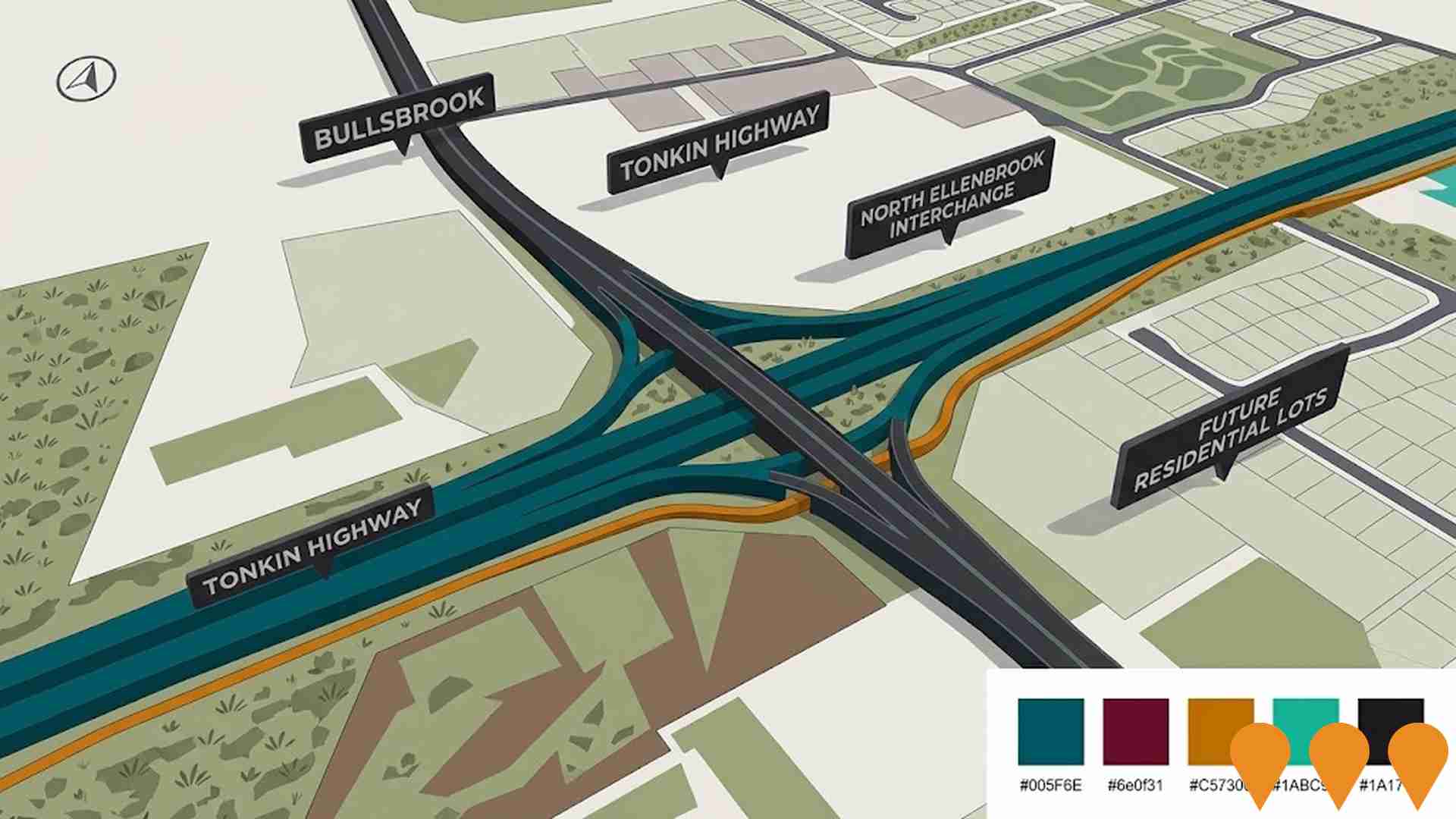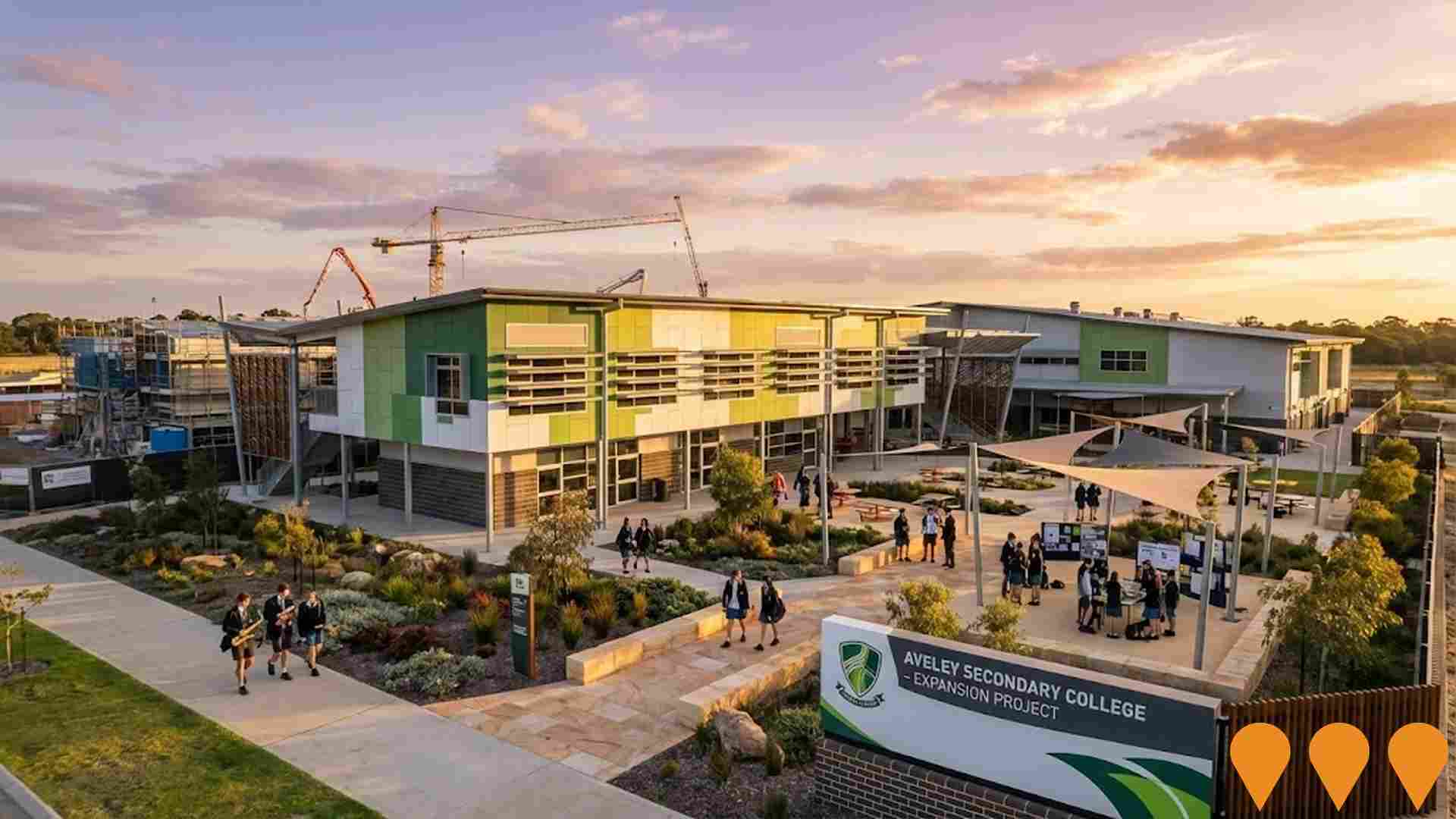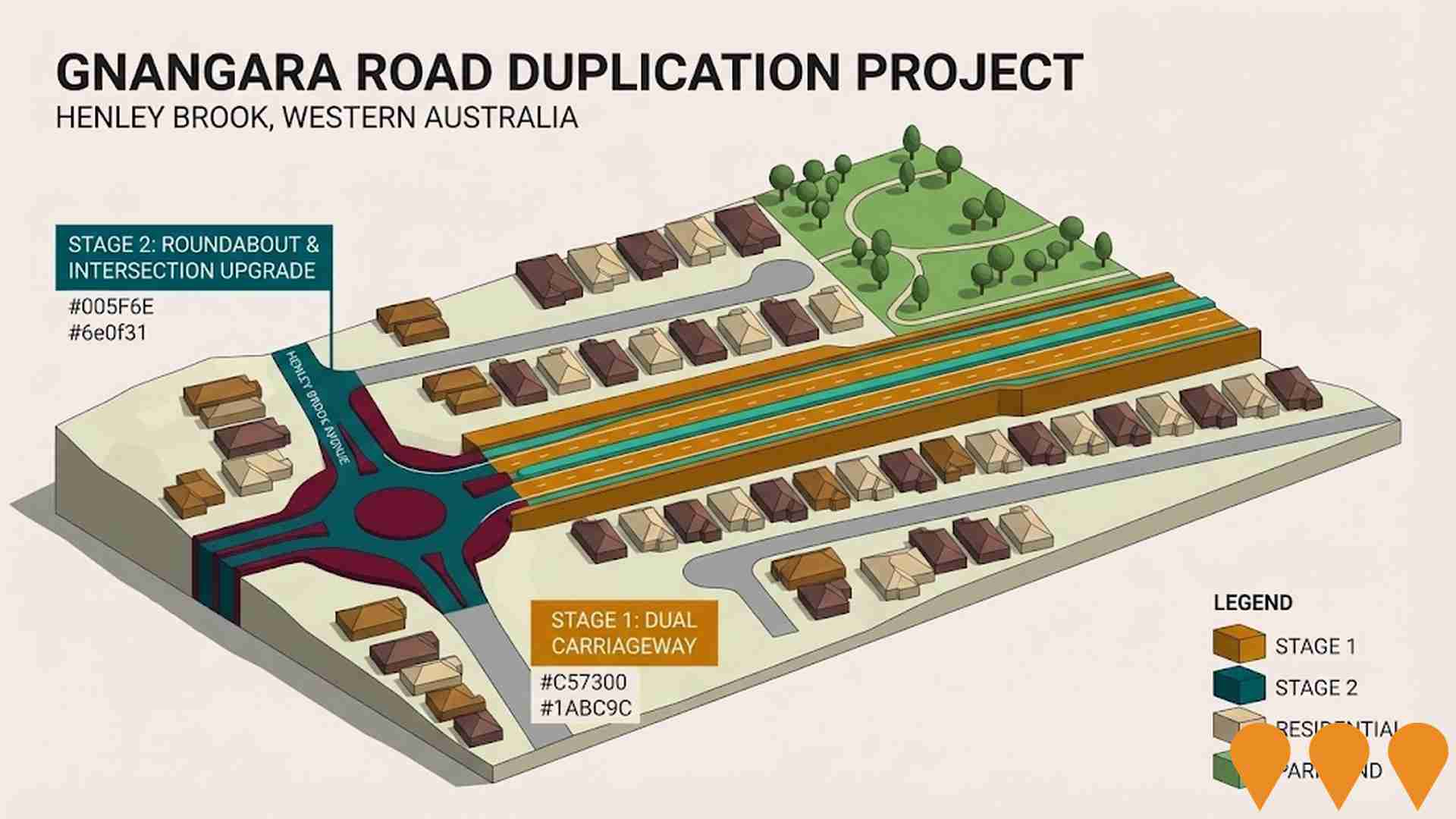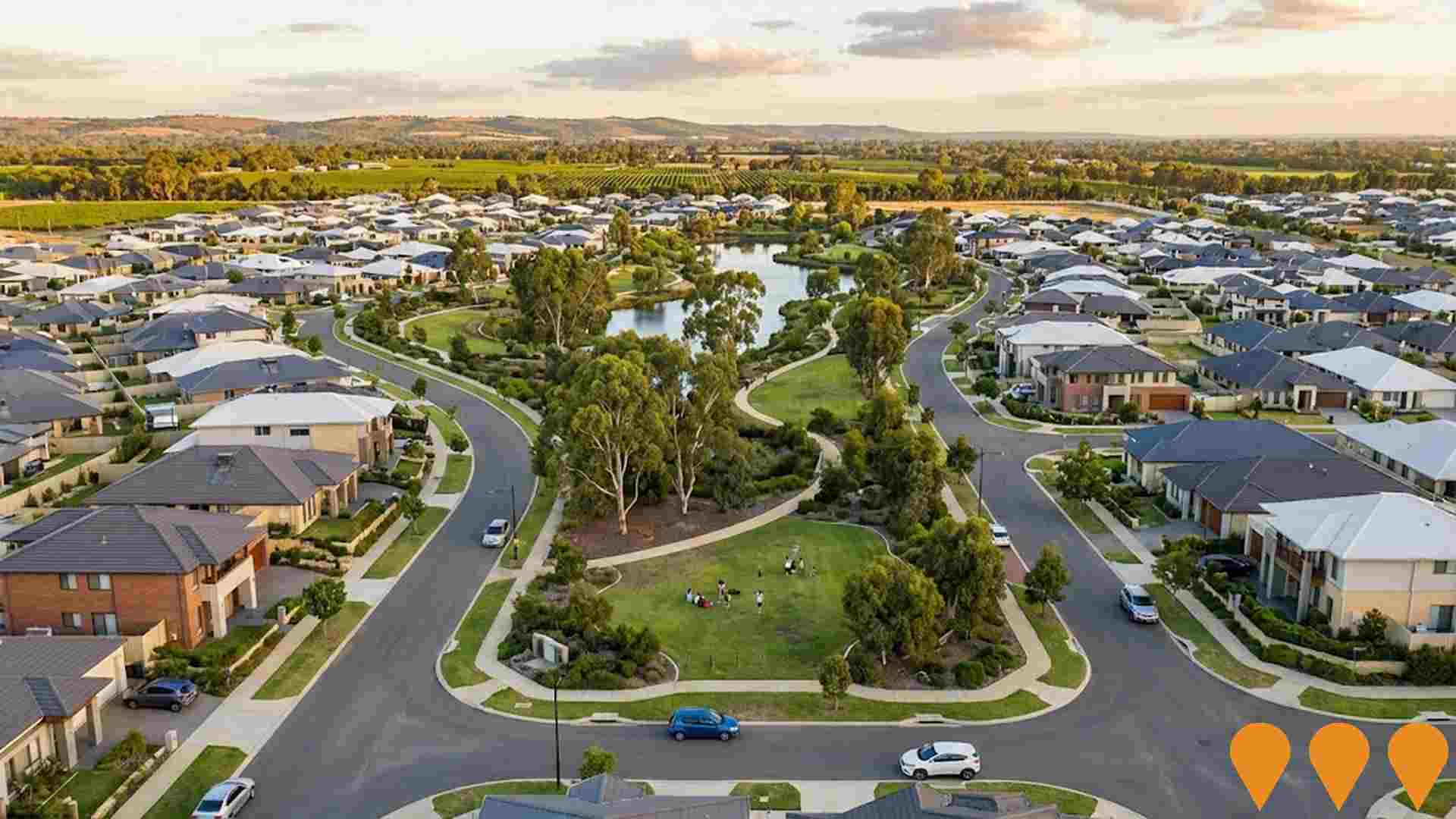Chart Color Schemes
est. as @ -- *
ABS ERP | -- people | --
2021 Census | -- people
Sales Activity
Curious about local property values? Filter the chart to assess the volume and appreciation (including resales) trends and regional comparisons, or scroll to the map below view this information at an individual property level.
Find a Recent Sale
Sales Detail
Population
The Vines lies within the top 10% of areas nationally in terms of population growth performance according to AreaSearch analysis of short and medium-term trends
AreaSearch's analysis indicates that The Vines' population was approximately 15,861 as of August 2025. This figure represents an increase of 3,404 people, a rise of 27.3% since the 2021 Census which reported a population of 12,457. The change is inferred from the estimated resident population of 15,135 in June 2024 and an additional 805 validated new addresses since the Census date. This results in a density ratio of 236 persons per square kilometer, suggesting ample space per person and potential for further development. The Vines' growth of 27.3% since the 2021 census surpassed both the national average (8.6%) and state averages, positioning it as a growth leader in the region. Interstate migration contributed approximately 58.8% of overall population gains during recent periods, with natural growth and overseas migration also being positive factors.
AreaSearch adopts ABS/Geoscience Australia projections for each SA2 area, released in 2024 using 2022 as the base year. For areas not covered by this data and to estimate post-2032 growth, AreaSearch uses growth rates by age cohort provided by the ABS in its latest Greater Capital Region projections, released in 2023 based on 2022 data. Future population trends forecast a significant increase for The Vines, with an expected rise of 3,961 persons to reach a total population of 19,822 by 2041, reflecting a 20.4% increase over the 17-year period.
Frequently Asked Questions - Population
Development
The level of residential development activity in The Vines was found to be higher than 90% of real estate markets across the country
The Vines has experienced approximately 217 dwelling approvals per year over the past five financial years, totalling 1089 homes. As of FY-26, 94 approvals have been recorded. On average, each dwelling has accommodated 2.9 new residents annually between FY-21 and FY-25, reflecting strong demand that supports property values. The average construction cost value for new homes is $391,000, aligning with broader regional development trends.
In FY-26, commercial approvals worth $2.9 million have been registered, indicating limited focus on commercial development. Compared to Greater Perth, The Vines has seen 27.0% more development per person over the past five years, offering good buyer choice while supporting existing property values, and reflecting strong developer confidence in the area. New development consists of 99.0% detached dwellings and 1.0% townhouses or apartments, preserving the area's low-density nature and attracting space-seeking buyers. With around 67 people per dwelling approval, The Vines exhibits characteristics of a growth area.
Future projections estimate that The Vines will add 3235 residents by 2041. Current construction levels should adequately meet demand, creating favourable conditions for buyers and potentially enabling growth exceeding current forecasts.
Frequently Asked Questions - Development
Infrastructure
The Vines has emerging levels of nearby infrastructure activity, ranking in the 28thth percentile nationally
The performance of an area can significantly be influenced by changes in local infrastructure. AreaSearch has identified a total of eighteen projects that are likely to impact the area. Notable projects include Centuria Ellenbrook Promenade Plaza, North Ellenbrook (West) District Structure Plan, Village 6 Malvern Springs Development Plan, and HomeCo Ellenbrook Retail Centre. The following list details those projects considered most relevant.
Professional plan users can use the search below to filter and access additional projects.
INFRASTRUCTURE SEARCH
 Denotes AI-based impression for illustrative purposes only, not to be taken as definitive under any circumstances. Please follow links and conduct other investigations from the project's source for actual imagery. Developers and project owners wishing us to use original imagery please Contact Us and we will do so.
Denotes AI-based impression for illustrative purposes only, not to be taken as definitive under any circumstances. Please follow links and conduct other investigations from the project's source for actual imagery. Developers and project owners wishing us to use original imagery please Contact Us and we will do so.
Frequently Asked Questions - Infrastructure
Bullsbrook Freight and Industrial Land Use Strategy
Long-term strategic framework to guide the development of over 2,500 hectares of industrial and employment land in Bullsbrook, supporting a future intermodal freight terminal and associated logistics and advanced manufacturing uses. Expected to generate up to 40,000 jobs over a 50+ year horizon.

Stockland Vale Aveley
Award-winning masterplanned community in Aveley, Western Australia, spanning 5,235 residential lots and featuring town centres, three schools, parks, and major recreational facilities. The development integrates with existing bushland, wetlands, and the Swan Valley character, and is one of the fastest-growing corridors in Western Australia. Land and house & land packages are currently for sale.
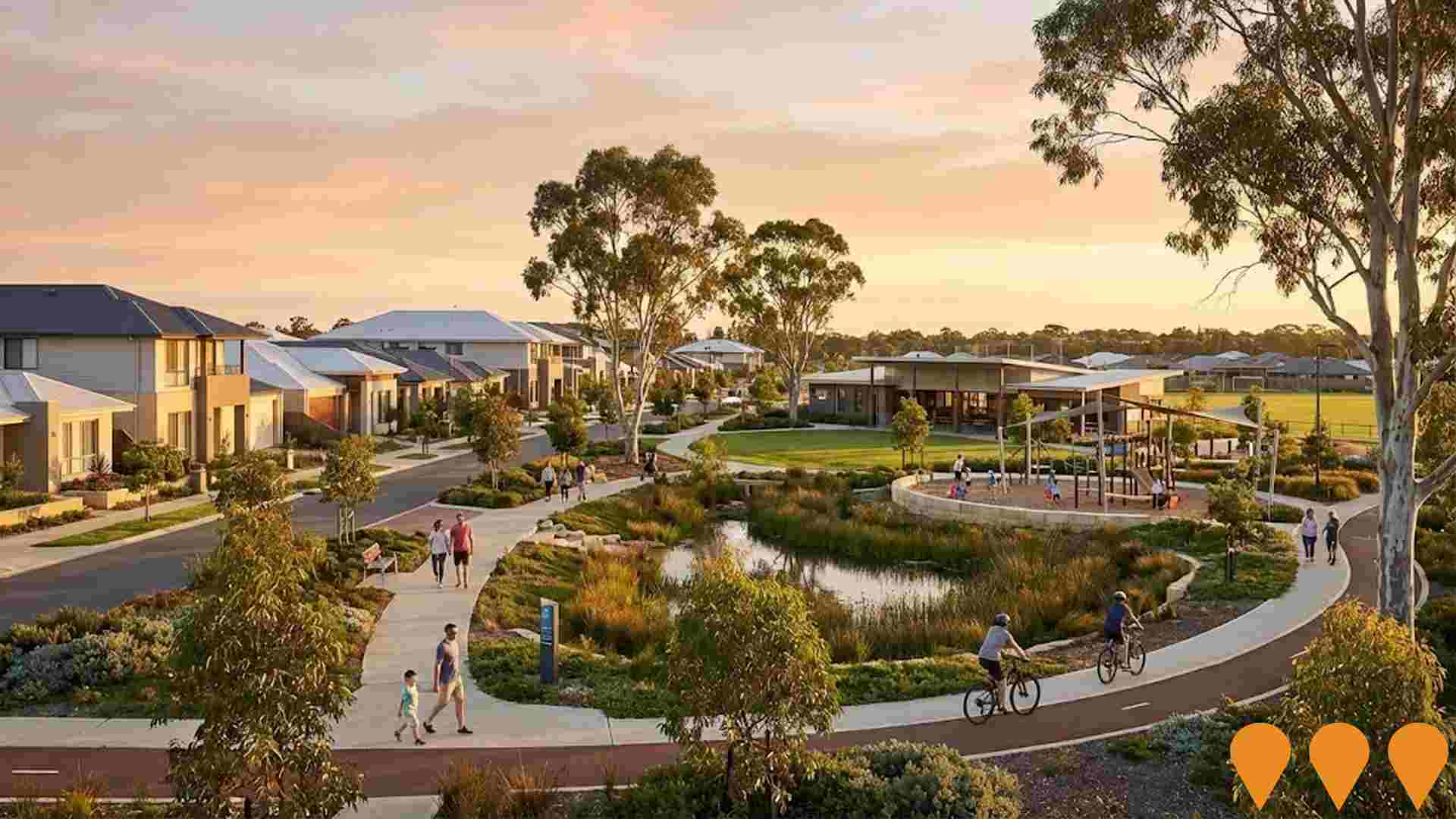
North Ellenbrook (West) District Structure Plan
Approved district structure plan setting the strategic framework for urbanisation of the North Ellenbrook West growth area in the City of Swan. The Western Australian Planning Commission has endorsed the East and West district structure plans as the basis for further detailed planning and investigation, with Amendment 1 to the West DSP adding around 163 hectares of additional urban land and planning for up to 7,500 residents. The West DSP provides for roughly 4,000 to 4,500 new dwellings, associated schools, activity centres, employment land, public open space and environmental corridors, supported by Metropolitan Region Scheme amendments that rezone about 393 hectares from Rural to Urban Deferred and Parks and Recreation. Parcel Property has led structure planning for the West, while private developers including Wolfdene and Oreana have acquired a 72 hectare site earmarked for about 800 lots and around 2,000 residents, with retail launches and initial construction targeted from 2029. The broader precinct will be linked to Tonkin Highway and the Ellenbrook METRONET station, forming a major new masterplanned community and employment node in Perths north east corridor.

Centuria Ellenbrook Promenade Plaza
Large-format retail and fast-food precinct developed by Centuria. Tenants include Revo Fitness (open), Hungry Jacks (open), KFC (open), Taco Bell (open), Starbucks (open), Anaconda, and multiple bulky goods/showroom tenancies. Stage 2 construction completed mid-2025 with all major tenants now trading.
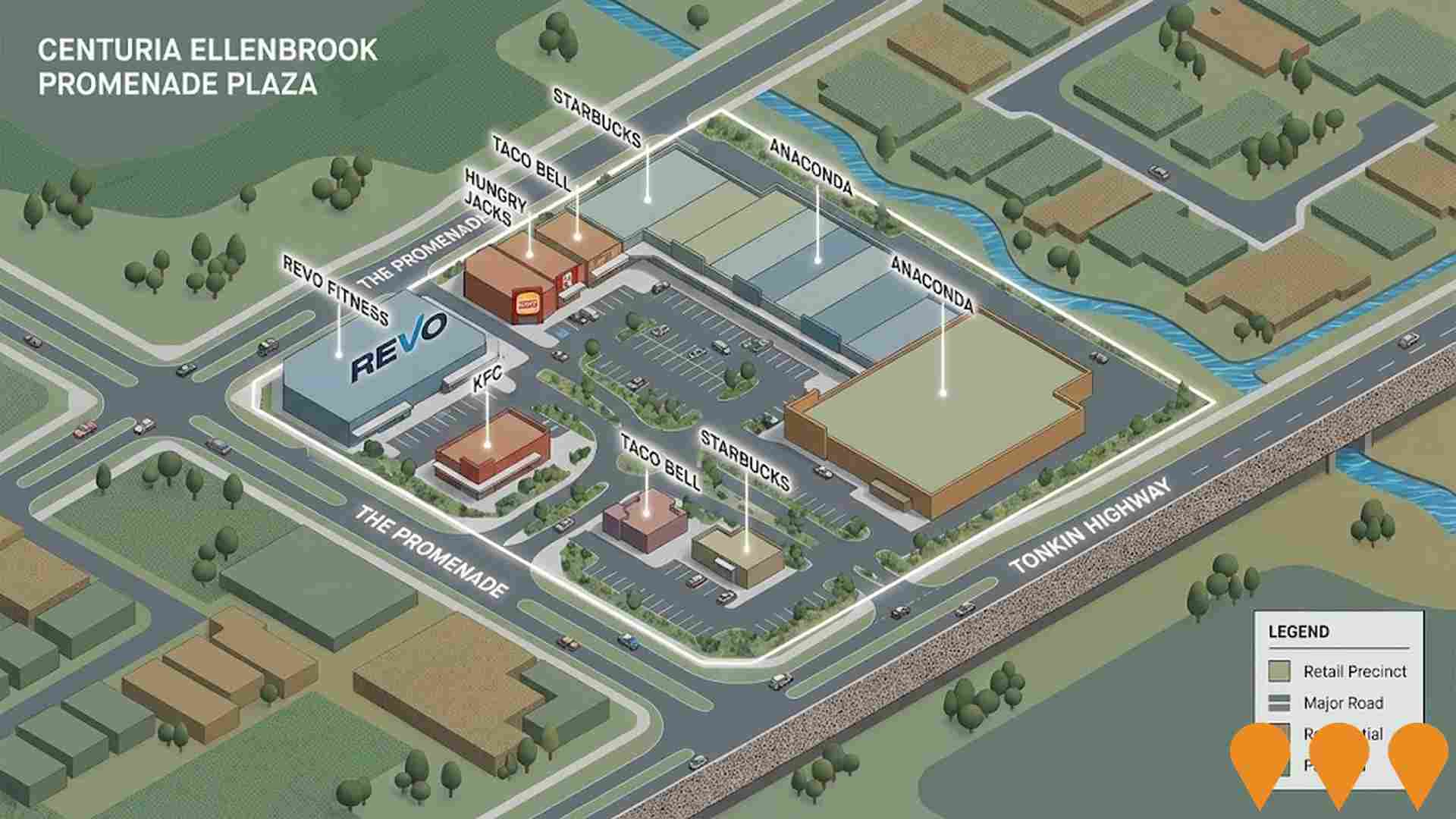
HomeCo Ellenbrook Retail Centre
Daily needs retail centre anchored by Spudshed with major tenants including Spotlight, Chemist Warehouse, The Reject Shop, Sydney Tools and more. Serves the Ellenbrook and Swan growth corridor with everyday convenience retail, large format retail and family amenities.
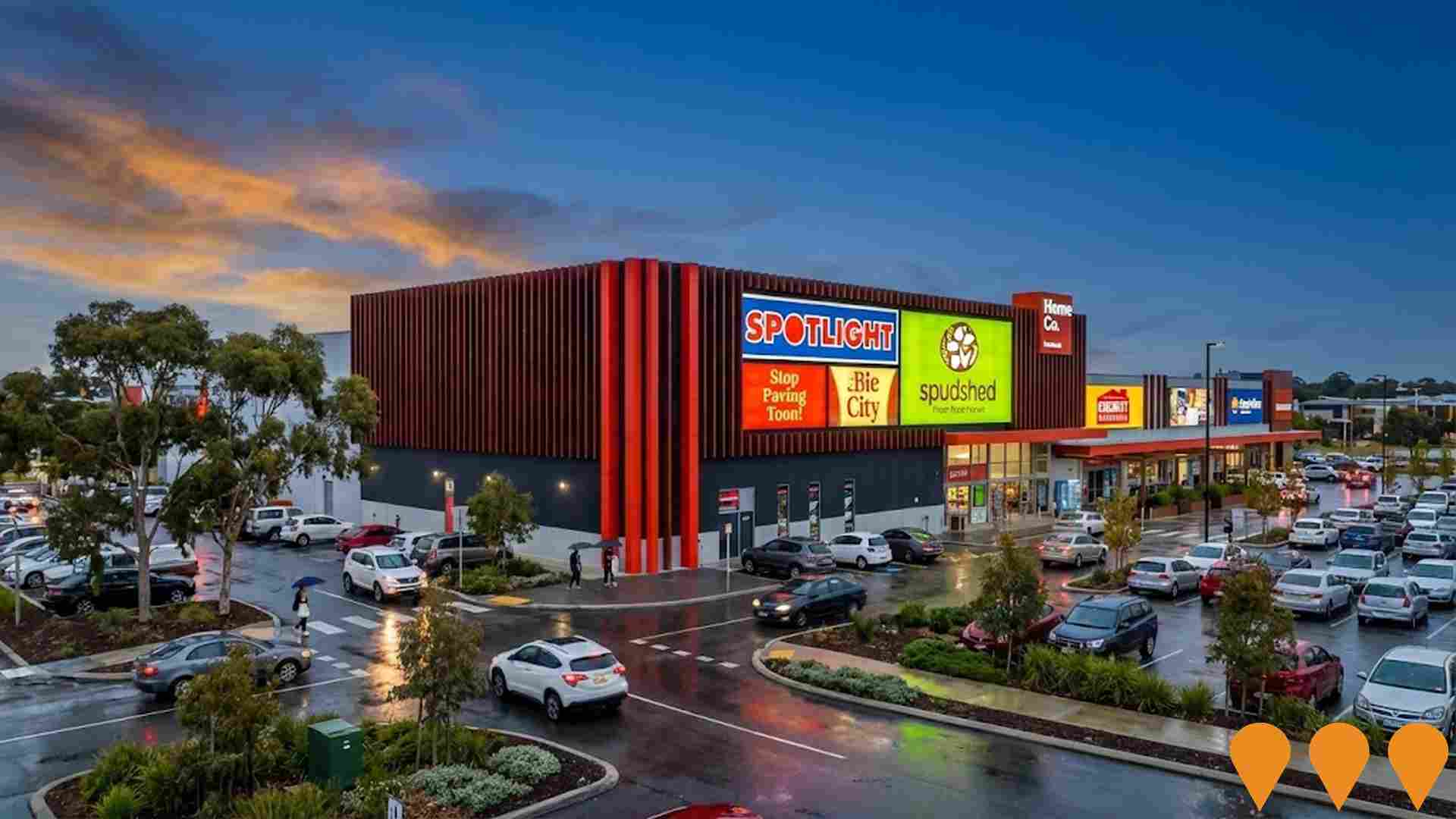
North Ellenbrook (East) District Structure Plan
499-hectare masterplanned residential community in Perth's north-east corridor led by Lendlease. Will deliver approximately 5,500 dwellings for up to 16,500 residents. District Structure Plan approved by WAPC in August 2022. Metropolitan Region Scheme Amendment 1399/41 (North Ellenbrook) was gazetted on 17 December 2024, lifting Urban Deferred status and rezoning the land to Urban zone, enabling subdivision and development to proceed. Includes future high school site, multiple primary schools, neighbourhood centre, district playing fields and conservation areas protecting threatened ecological communities and Western Swamp Tortoise habitat.

Ellenbrook Railway Station
Terminus station on the Ellenbrook Line (formerly Morley-Ellenbrook Line) with a 150 m island platform, about 500 parking bays, a 12-stand bus interchange, full accessibility and integrated town centre connections. Station opened in December 2024 as part of the new Ellenbrook Line connecting Ellenbrook to Bayswater and the broader Transperth network.

Dayton District Open Space
A 15ha community recreation precinct with sports pavilions, youth facilities, AFL and cricket ovals, synthetic and grass hockey fields, multi-use/netball courts, play spaces and a family hub serving the Swan Urban Growth Corridor. Stage 2 reached practical completion in 2024 and the site is open for community use.
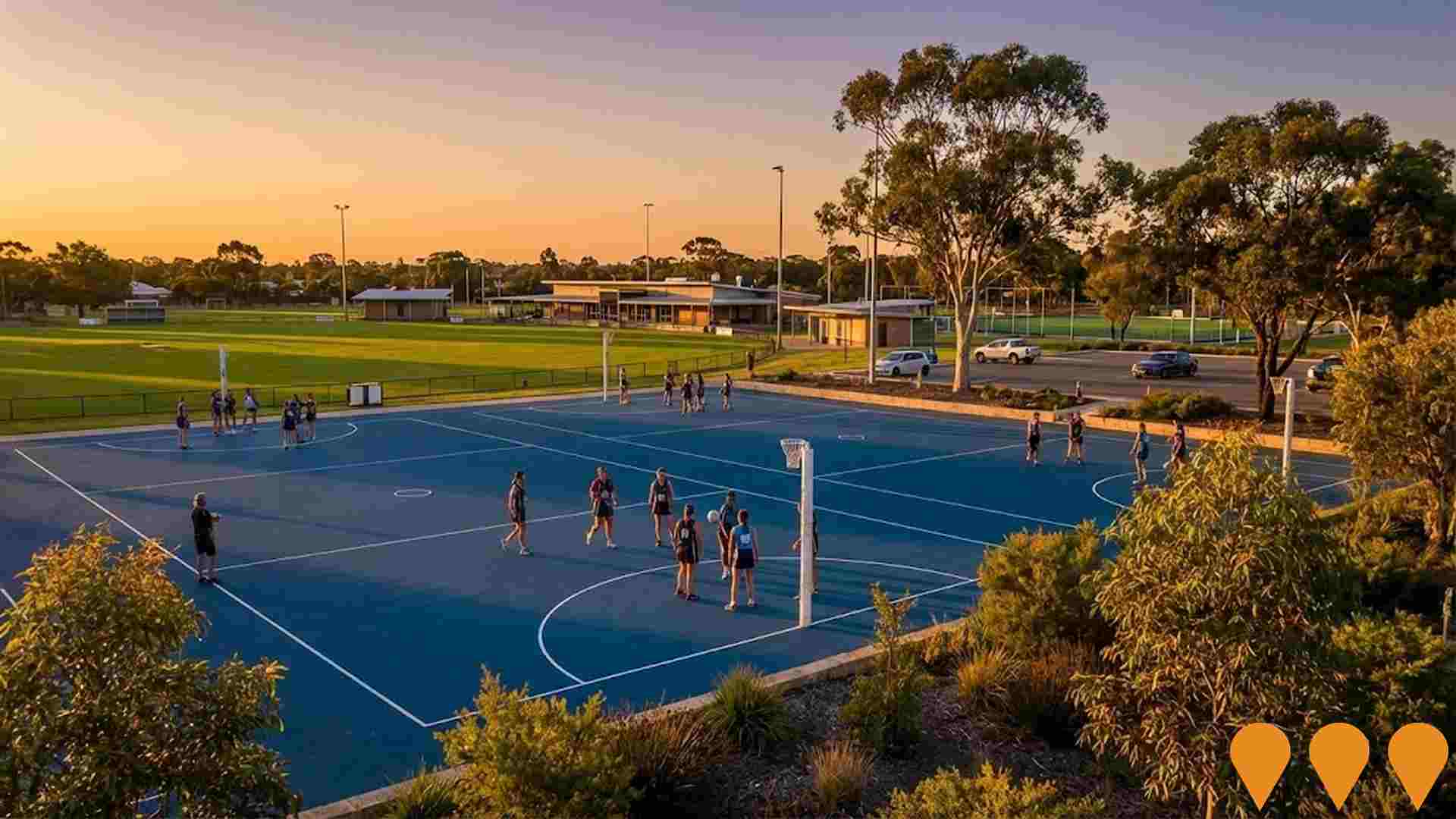
Employment
AreaSearch analysis places The Vines well above average for employment performance across multiple indicators
The Vines has a skilled workforce with strong representation in manufacturing and industrial sectors. Its unemployment rate was 3.2% as of June 2025, which is below Greater Perth's rate of 3.9%.
Employment growth over the past year was estimated at 3.1%. As of June 2025, 8,470 residents were employed, with a workforce participation rate of 70.2%, compared to Greater Perth's 65.2%. Key employment sectors are health care & social assistance, construction, and retail trade. The area has notable concentration in mining, with employment levels at 1.3 times the regional average.
However, professional & technical services have limited presence, with 5.6% employment compared to the regional average of 8.2%. Employment opportunities locally may be limited, as indicated by the difference between Census working population and resident population. Over the past year, employment increased by 3.1%, while the labour force grew by 4.1%, leading to a rise in unemployment rate by 1.0 percentage points. In contrast, Greater Perth saw employment rise by 3.7% and unemployment increase by only 0.1 percentage points. According to Jobs and Skills Australia's national employment forecasts from May 2025, national employment is projected to expand by 6.6% over five years and 13.7% over ten years. Applying these projections to The Vines' employment mix suggests local growth of approximately 5.9% over five years and 12.6% over ten years, though these are simple weighting extrapolations for illustrative purposes and do not account for localised population projections.
Frequently Asked Questions - Employment
Income
Income metrics indicate excellent economic conditions, with the area achieving higher performance than 75% of national locations assessed by AreaSearch
The Vines' income level is very high nationally according to latest ATO data aggregated by AreaSearch for financial year 2022. The median income among taxpayers in The Vines is $59,616 and the average income stands at $71,408. These figures compare to those of Greater Perth's median income of $58,380 and average income of $78,020 respectively. Based on Wage Price Index growth of 14.2% since financial year 2022, current estimates for The Vines would be approximately $68,081 (median) and $81,548 (average) as of September 2025. Census data reveals that household, family, and personal incomes in The Vines all rank highly nationally, between the 72nd and 79th percentiles. The earnings profile shows that the $1,500 - 2,999 income bracket dominates with 34.9% of residents (5,535 people), reflecting patterns seen in the broader area where 32.0% similarly occupy this range. A significant 32.8% earn above $3,000 weekly, indicating pockets of prosperity that drive robust local economic activity. High housing costs consume 16.3% of income, but strong earnings still place disposable income at the 78th percentile nationally. The area's SEIFA income ranking places it in the 6th decile.
Frequently Asked Questions - Income
Housing
The Vines is characterized by a predominantly suburban housing profile, with above-average rates of outright home ownership
The Vines' dwelling structure, as per the latest Census, consisted of 94.0% houses and 6.0% other dwellings (semi-detached, apartments, 'other' dwellings), compared to Perth metro's 89.1% houses and 10.9% other dwellings. Home ownership in The Vines stood at 23.8%, with mortgaged dwellings at 62.1% and rented ones at 14.1%. The median monthly mortgage repayment was $2,167, higher than Perth metro's average of $1,842. The median weekly rent in The Vines was $370, compared to Perth metro's $340. Nationally, The Vines' mortgage repayments were significantly higher at $2,167 versus the Australian average of $1,863, while rents were lower at $370 compared to the national figure of $375.
Frequently Asked Questions - Housing
Household Composition
The Vines features high concentrations of family households, with a higher-than-average median household size
Family households constitute 83.9% of all households, including 44.2% couples with children, 28.5% couples without children, and 10.5% single parent families. Non-family households comprise the remaining 16.1%, with lone person households at 14.7% and group households at 1.4%. The median household size is 3.0 people, larger than the Greater Perth average of 2.8.
Frequently Asked Questions - Households
Local Schools & Education
Educational attainment in The Vines aligns closely with national averages, showing typical qualification patterns and performance metrics
The area's university qualification rate in 20.1% is significantly lower than the Australian average of 30.4%. Bachelor degrees are most common at 13.7%, followed by postgraduate qualifications (3.9%) and graduate diplomas (2.5%). Vocational credentials are prominent, with 41.2% of residents aged 15+ holding such qualifications - advanced diplomas at 12.7% and certificates at 28.5%. Educational participation is high, with 32.1% of residents currently enrolled in formal education.
This includes 12.6% in primary education, 9.4% in secondary education, and 4.2% pursuing tertiary education. The area has two primary schools - Anne Hamersley Primary School and Upper Swan Primary School - serving a total of 1,177 students. These schools demonstrate typical Australian school conditions (ICSEA: 994) with balanced educational opportunities. Both schools focus exclusively on primary education, with secondary options available in surrounding areas. Local school capacity is limited at 7.4 places per 100 residents compared to the regional average of 15.7, leading many families to travel for schooling.
Frequently Asked Questions - Education
Schools Detail
Nearby Services & Amenities
Transport
Transport servicing is low compared to other areas nationally based on assessment of service frequency, route connectivity and accessibility
The public transport analysis indicates there are currently seventy active transport stops functioning within The Vines. These stops offer a variety of bus services, totaling six individual routes that facilitate one thousand two hundred seventy weekly passenger trips in aggregate. Transport accessibility is assessed as limited, with residents generally situated seven hundred twenty-five meters away from the nearest transport stop.
Service frequency averages one hundred eighty-one trips daily across all routes, translating to approximately eighteen weekly trips per individual stop.
Frequently Asked Questions - Transport
Transport Stops Detail
Health
The Vines's residents boast exceedingly positive health performance metrics with very low prevalence of common health conditions across all age groups
Health outcomes data shows excellent results throughout The Vines, with a very low prevalence of common health conditions across all age groups.
Approximately 55% (~8,723 people) of the total population has private health cover. Mental health issues and asthma are the most prevalent medical conditions in the area, affecting 7.3 and 7.1% of residents respectively. A significant majority, 74.1%, report being completely free from medical ailments, compared to 72.6% across Greater Perth. The area has a senior population of 13.4% (2,126 people), with seniors' health outcomes aligning closely with the general population's profile.
Frequently Asked Questions - Health
Cultural Diversity
The Vines was found to be more culturally diverse than the vast majority of local markets in Australia, upon assessment of a range of language and cultural background related metrics
The Vines was found to have a higher cultural diversity than most local markets, with 15.0% of its population speaking a language other than English at home and 33.8% born overseas. Christianity is the predominant religion in The Vines, making up 48.6% of its population. Notably, the 'Other' religious category comprises 1.3%, compared to the regional average of 2.4%.
In terms of ancestry, the top three groups are English at 31.2%, Australian at 22.3%, and Other at 11.1%. Some ethnic groups show significant differences: South African is overrepresented at 1.5% (compared to 0.8% regionally), Maori at 1.6% (vs 1.4%), and New Zealand at 1.2% (vs 1.0%).
Frequently Asked Questions - Diversity
Age
The Vines's population is slightly younger than the national pattern
At 36 years, The Vines's median age is nearly matching Greater Perth's average of 37, which is modestly under the Australian median of 38. Relative to Greater Perth, The Vines has a higher concentration of residents aged 5-14 (15.8%) but fewer residents aged 25-34 (11.1%). According to the Census conducted in May 2021, the population aged 15 to 24 grew from 12.3% to 13.4%. Conversely, the 0 to 4 age group declined from 7.3% to 6.0%. Demographic modeling suggests that The Vines's age profile will evolve significantly by 2041. The 55 to 64 cohort is projected to grow strongly at a rate of 35%, adding 647 residents to reach 2,516. In contrast, both the 0 to 4 and 35 to 44 age groups are expected to see reduced numbers.
